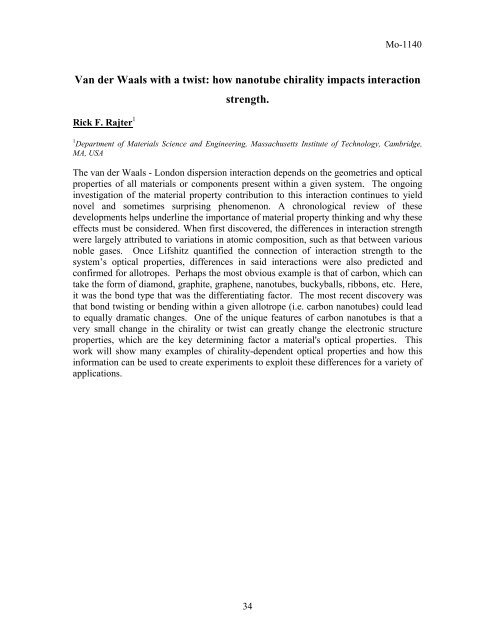Noncontact Atomic Force Microscopy - Yale School of Engineering ...
Noncontact Atomic Force Microscopy - Yale School of Engineering ...
Noncontact Atomic Force Microscopy - Yale School of Engineering ...
Create successful ePaper yourself
Turn your PDF publications into a flip-book with our unique Google optimized e-Paper software.
Mo-1140<br />
Van der Waals with a twist: how nanotube chirality impacts interaction<br />
Rick F. Rajter 1<br />
strength.<br />
1Department <strong>of</strong> Materials Science and <strong>Engineering</strong>, Massachusetts Institute <strong>of</strong> Technology, Cambridge,<br />
MA, USA<br />
The van der Waals - London dispersion interaction depends on the geometries and optical<br />
properties <strong>of</strong> all materials or components present within a given system. The ongoing<br />
investigation <strong>of</strong> the material property contribution to this interaction continues to yield<br />
novel and sometimes surprising phenomenon. A chronological review <strong>of</strong> these<br />
developments helps underline the importance <strong>of</strong> material property thinking and why these<br />
effects must be considered. When first discovered, the differences in interaction strength<br />
were largely attributed to variations in atomic composition, such as that between various<br />
noble gases. Once Lifshitz quantified the connection <strong>of</strong> interaction strength to the<br />
system’s optical properties, differences in said interactions were also predicted and<br />
confirmed for allotropes. Perhaps the most obvious example is that <strong>of</strong> carbon, which can<br />
take the form <strong>of</strong> diamond, graphite, graphene, nanotubes, buckyballs, ribbons, etc. Here,<br />
it was the bond type that was the differentiating factor. The most recent discovery was<br />
that bond twisting or bending within a given allotrope (i.e. carbon nanotubes) could lead<br />
to equally dramatic changes. One <strong>of</strong> the unique features <strong>of</strong> carbon nanotubes is that a<br />
very small change in the chirality or twist can greatly change the electronic structure<br />
properties, which are the key determining factor a material's optical properties. This<br />
work will show many examples <strong>of</strong> chirality-dependent optical properties and how this<br />
information can be used to create experiments to exploit these differences for a variety <strong>of</strong><br />
applications.<br />
34















